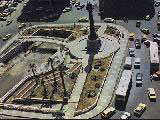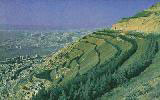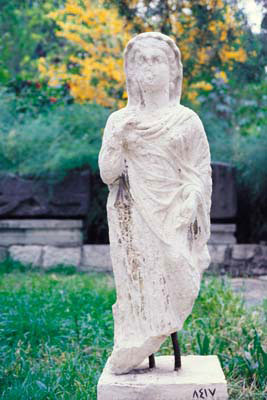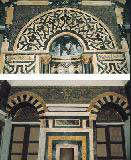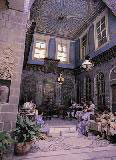Ever since the eleventh century, when the old city was already too small for its inhabitants and their houses, the city started to expand beyond its walls.
In the Nuri and Ayoubite periods new suburbs emerged; they were separate and independent of the city proper, but they, in turn, continued to grow at such a rate during the Mamluk period that they joined the wall, and the old city became indistinguishable from the new. Most notable among the suburbs was al-Salhieh at the foot of jabal Qassiun, al-Uqiba, al-Midan, and al-Mazzeh, Mamluk princes and sultans also erected numerous schools and mosques beyond the old city walls. During the Ottoman period four new edifices were constructed, namely: Sheikh Muhieddin, al-Takieh al-Suleimaniyeh, al-Darwishieh, and al-Sinanieh. In the nineteenth century, new roads were built across the city along with new residential areas. European architectural styles started to appear. Most important among the buildings of this period are: al-Hamidiyeh Barracks (where part of the University of Damascus stands today), al-Saraya (now housing the Ministry of the Interior), al-Muhajirin Palace (the former Presidential Palace), the National Hospital, and the Law School (now being renovated to accommodate the Ministry of Tourism). Construction of new roads, bridges, hospitals, public parks, hotels, government offices, and new residential suburbs began after Independence and is still going strong today.
Places of interest to the visitor are:
1- The National Museum.
2- Al-Takieh al-Suleimaniyeh.
3- The City of Damascus Historical Museum.
4- Al-Salhieh.
The National Museum of Damascus
Founded in 1919, initially installed at the Madrasseh al Adiliyeh. The construction of a new building was between 1935 and 1979 and it becomes the central Museum of Syria. Since then the following monuments had been reconstructed within this Museum:
- The hypogeum of Yarhay from Palmyra, 108 A.D.
- The Synagogue of Dura Europos, mid 3rd century A.D.
- The facade of Qasr al-Hair al Gharbi, dated to 727 A.D.
- One of the entries of Yalbugha Mosque.
- The Damascus reception hall of 1737 A.D.
1- Prehistory Museum contains artifacts and objects discovered in the basin of the Orontes, the Euphrates, at Tell Ramad.
2- Museum of Ancient Syrian Antiquities : contain an Amorite, Canaanite and Eblaite antiquities discovered at Ugarit, of which is the alphabet the most important, at Mari, where the statue of Ur-Nina, of Ishtar, the model of a circular house had been found; at Ebla, where the famous archive, the cult basin, the bust of a king... had been brought to light, and many other antiquities from Amrit, Tell Sukas, Tell Khueira…etc.
3- Museum of classical Antiquities: conserves sculptures discovered in Hauran, Djebel al-Arab, Djoulan; mosaics, Palmyrenean antiquities, frescos from Dura Europos, jewelleries and coins…
4- Museum of Arab-Islamic Arts: conserves windows of stucco, fresco of Qasr al-Hair, ceramics, faiences, manuscripts, cenotaph of Khaled Ben al-Walid and of Khatoun.
5- Museum of Contemporary Art: contains works of Syrian artists and artists of Arab and friend countries.
6- Open Air Museum within the garden of the National Museum: exposes antiquities of stones from different periods.
Al-Takieh al-Suleimaniyeh
A remarkable example of Ottoman architecture; it was built by order of Sultan Suleiman al-Qanouni (hence the name) in 1554.
It was erected on the site of the famous palace of Zhaher Bybars, and designed by the celebrated architect Sinan. Most striking are its two elegant minarets. It is divided into two parts: the great Takieh which consists of a mosque and a school, and the minor Takieh with a prayer hall and a large patio surrounded by archways, arcades and rooms, now housing the handicraft market.
The City of Damascus Historical Museum
An eighteenth-century building, which, like al-Azem Palace, is considered a fine example of old Damascene houses. It contains historical documents relating to the inhabitants of the city of Damascus.
Al-Salhieh
Situated at the foot of mount Qassiun which overlooks Damascus. Building in this area started in the eleventh century to accommodate refugees arriving from Jerusalem following the Crusader occupation of the city. Here you find numerous old schools and hospitals, as well as mosques and the shrines of prominent Muslim thinkers and Sufi leaders such as Muhieddin Ibn Arabi and Abd al-Ghani al-Nabulsi. In the Muhieddin district, a colossal wooden noria was erected in the thirteenth century, based on a design made by al-Jazri, the leading mechanic of his time. It lifted water from the river Yazid to a height of 12 metres to supply al-Qaimarieh Hospital at al-Salhieh. It is the only one remaining of a great many norias that were scattered all over the district. There is still an alley called the Noria Alley.
